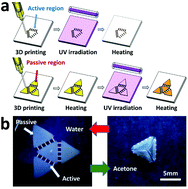4D printing of a self-morphing polymer driven by a swellable guest medium†
Abstract
There is a significant need of advanced materials that can be fabricated into functional devices with defined three-dimensional (3D) structures for application in tissue engineering, flexible electronics, and soft robotics. This need motivates an emerging four-dimensional (4D) printing technology, by which printed 3D structures consisting of active materials can transform their configurations over time in response to stimuli. Despite the ubiquity of active materials in performing self-morphing processes, their potential for 4D printing has not been fully explored to date. In this study, we demonstrate 4D printing of a commercial polymer, SU-8, which has not been reported to date in this field. The working principle is based on a self-morphing process of the printed SU-8 structures through spatial control of the swelling medium inside the polymer matrix by a modified process. To understand the self-morphing behavior, fundamental studies on the effect of the geometries including contours and filling patterns were carried out. A soft electronic device as an actuator was demonstrated to realize an application of this programmable polymer using the 3D printing technology. These studies provide a new paradigm for application of SU-8 in 4D printing, paving a new route to the exploration of more potential candidates by this demonstrated strategy.



 Please wait while we load your content...
Please wait while we load your content...